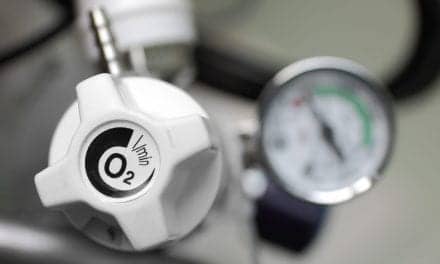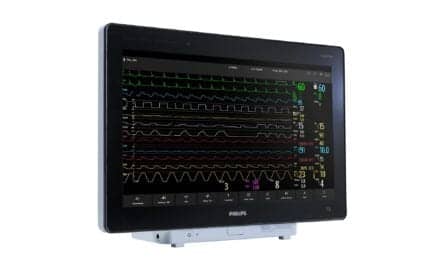Cystic fibrosis is the most common cause of bronchiectasis, however, non-CF bronchiectasis affects a significant percentage of lung disease patients and the number of diagnosed cases continues to grow.
Bronchiectasis is a disease of the airways where the bronchi are permanently damaged from bacterial infections and inflammation. The bronchi are dilated and distorted as result of chronic inflammation and repeated infection. The end results and symptoms include excessive sputum production, atelectasis mixed with hyperinflated alveoli, consolidation (and possible fibrosis), impaired mucociliary action, cough and dyspnea. Cystic fibrosis (CF) is the most common cause of bronchiectasis and there is a distinction made between CF and nonCF bronchiectasis in the literature.1-2 This paper will examine nonCF bronchiectasis (nCFB) and the issues related to secretion clearance.
Epidemiology, symptoms, and pathology
The COPD Foundation established the Bronchiectasis Research Registry (BRR) in 2008 to provide a resource for clinical trials and other research. From 2008 and 2014 the registry has enrolled 1,826 patients. From this pool, characteristics of patients with nCFB reveals that 79% were female, 89% were white, and 60% have never smoked. The mean age of those in the registry was 64 + 14 years. A history of nontuberculosis mycobacteria (NTM) was found in 63%. Spirometry was done in 85% of the population and showed evidence of airflow obstruction in 51% of those who had these measurements on record. The prevalence of nCFB appears to be increasing (between 2000 and 2007 prevalence increased 8.74% annually).3
Cough was the most frequent symptom (reported by 73%) and a productive cough was the next most frequent symptom (53% produced sputum). Dyspnea and fatigue were the next two symptoms reported (64% and 50% respectively). 85% of the pool had computed tomography (CT) scan results.3 According to Des Jardins’ textbook on respiratory diseases, high-resolution computed tomography (HRCT) has become the gold standard for diagnosis.4
nCFB results in excessive secretions and bronchospasm, with consolidation and thickening of the alveolar-capillary membrane. Depending on the severity of the disease nCFB may be classified as an obstructive disorder due to partial obstruction in the airways by inflammation and bronchospasm, or as a fibrotic disorder if the bronchi are completely blocked resulting in collapse and atelectasis of alveolar structures with consolidation, or a combination of both disorders. Hypoxemia, cyanosis, increased anterior-posterior diameter, wheezing, crackles, and coughing large amounts of foul-smelling sputum are often found in the physical examination. Arterial blood gas results show chronic ventilator failure with hypoxemia and during an exacerbation may exhibit acute-on-chronic ventilator failure with increased hypoxemia). Examination of the sputum often reveals Streptococcus pneumonia, Haemophilus influenza, Pseudomonas aeruginosa, and one or more acid-fast bacillus cultures.3-4
Treatment
Controlling pulmonary infections, managing airway secretions, and preventing complications from nCFB are the three main components of managing the disease.4 Treatment includes pharmacologic and non-pharmacologic therapy. Pharmacologic therapy often includes antibiotics, inhaled steroids, inhaled bronchodilators, treatment for gastroesophageal reflux disease (if present), and use of mucus-active agents (hypertonic saline is used in 76% of those patients using mucus-active agents according to the BRR).3
Nonpharmacologic treatment is often described as airway clearance therapy (ACT) in the literature. ACT includes many approaches including chest percussion/postural drainage (CP/PD), vibrating (or oscillating) positive expiratory pressure devices (VPEP or OPEP), high-frequency chest wall oscillation (or compression) (HFCWO or HFCWC), intra-pulmonary ventilation (IPV), slow expiration with the glottis opened in a lateral posture or ELTGOL (L’Expiration Lente Totale Glotte Ouverte en décubitus Latéral), directed cough (ie “huffing”), mechanical insufflation-exsufflation, and active cycle of breathing techniques (ACBT).1,2,5,6,7,8 For the rest of this article we will focus on the nonpharmacologic treatment approaches for airway clearance.
Research in ACT
Research into the effectiveness of ACT is growing. Studies have taken a variety of approaches for examining effectiveness. There has been many published research articles for using ACT in CF patients—but this research does not easily translate over to application in patients with bronchiectasis. For the research that examines ACT in bronchiectasis, some have studied an approach/device versus a sham, or an approach/device versus another, or examined an approach/device in changing symptoms, physiologic measurement, or patient perception. Studies have been designed as cross-over trials, few are placebo-controlled, many are randomized, some are very short term (ie looking at the outcomes after a single treatment, and others are short-term (up to 6 weeks or 12 weeks). Another major drawback in the research on ACT is that there have been very little long-term research projects published. It has been noted that a very recently published study looked at outcomes after a year of therapy9 but a casual review of recent publications found no other long-term measurement of ACT in bronchiectasis. Research outcomes have included examining changes in the following:6
- Sputum production (measured by wet weight, dry weight or by volume)
- Lung function (measured by changes in FEV1, FVC, FEV1/FVC, RV, FRC, TLC, RV/TLC)
- Gas exchange – oxygen saturation (measured by PaO2 or SpO2) or carbon dioxide measured by PCO2
- Frequency or duration of exacerbations and/or hospitalizations
- Patient perception on dyspnea, cough severity, chest discomfort or quality of life using standardized questionnaires such as the St George’s Respiratory Questionnaire (SGRQ), the Borg Rating of Perceived Exertion Scale, the Modified Medical Research Council Dyspnea Scale (mMRC), and the COPD Assessment Test (CAT)
In a recent publication in Respiratory Care, researchers examined several unique outcomes including sputum adhesiveness, purulence, mucociliary transport, displacement in a simulated cough machine, contact angel measurement, cytology, and microbiology.2
The American Association for Respiratory Care (AARC) released a clinical practice guideline (CPG) regarding ACT in hospitalized patients in 2013.8 The AARC-CPG recommends that several steps be followed in the process for utilizing ACT for patients with retained secretions:
- Examine the rationale for using ACT. Is the patient having a problem clearing secretions from the airway? Are secretions affecting oxygenation/ventilation (reflected in assessment of gas exchange) or affecting work of breathing?
- What are the potential risks versus benefits of ACT with the patient? Risks are usually low but need to be considered.
- Airway clearance carries a cost in terms of device(s) or personnel time. Which approach or combinations are justifiable?
- What technique does the patient prefer? Portability, comfort, time needed to do the therapy, ease of use, issues with cleaning equipment, and more, may play a role for the patient and influence the decision for which approach is best.
- What are the expected outcomes and over what period of time? If outcomes are not met during the time specified, the therapy should be discontinued and/or another option explored for secretion clearance.
Conclusion
As stated in an article in Respiratory Care 2015 on airway clearance: “The respiratory therapist’s role in recommending airway clearance therapies is centered on being an advocate for the patient and identifying appropriate airway clearance techniques based on clinical indications, solid benefit-burden analysis, and cost analysis while also integrating patient preference, comfort, and likelihood of long-term adherence.”7
Patients with bronchiectasis have retained secretions that can adversely affect their health and bring frequent exacerbations, hospitalizations, increased use of antibiotics, and potentially bring declining health and shorten their lives. Additional robust research needs to be done. Until this occurs, respiratory therapists must continue to be the patient’s advocate in order to help choose the best course of action. RT
Bill Pruitt, MBA, RRT, CPFT, AE-C, FAARC, is a senior instructor and director of clinical education in the department of Cardiorespiratory Sciences, College of Allied Health Sciences, at the University of South Alabama in Mobile.
References
- Snijders, D., Fernandez Dominguez, B., Calgaro, S., Bertozzi, I., Escribano Montaner, A., Perilongo, G., & Barbato, A. (2015). Mucociliary clearance techniques for treating non-cystic fibrosis bronchiectasis: is there evidence? International Journal of Immunopathology and Pharmacology 2015, Vol. 28(2) 150–159.
- Tambascio, J., de Souza, H. C. D., Martinez, R., Baddini-Martinez, J. A., Barnes, P. J., & Gastaldi, A. C. (2017). Effects of an Airway Clearance Device on Inflammation, Bacteriology, and Mucus Transport in Bronchiectasis. Respiratory Care, 62(8), 1067-1074.
- Aksamit, T. R., O’Donnell, A. E., Barker, A., Olivier, K. N., Winthrop, K. L., Daniels, M. L. A., … & Metersky, M. (2017). Adult patients with bronchiectasis: a first look at the US bronchiectasis research registry. Chest, 151(5), 982-992.
- Des Jardins, T., & Burton, G. (2016) Bronchiectasis. Clinical Manifestations and Assessment of Respiratory Disease, 7th ed. Ch 14.
- Andrews, J., Sathe, N. A., Krishnaswami, S., & McPheeters, M. L. (2013). Nonpharmacologic airway clearance techniques in hospitalized patients: a systematic review. Respiratory Care, respcare-02704.
- Lee, A. L., Burge, A. T., & Holland, A. E. (2015). Airway clearance techniques for bronchiectasis. The Cochrane Library.
- Strickland, S. L. (2015). Year in review 2014: airway clearance. Respiratory care, 60(4), 603-605
- Strickland, S. L., Rubin, B. K., Drescher, G. S., Haas, C. F., O’Malley, C. A., Volsko, T. A., … & Hess, D. R. (2013). AARC clinical practice guideline: effectiveness of nonpharmacologic airway clearance therapies in hospitalized patients. Respiratory care, 58(12), 2187-2193.
- Muñoz, G., de Gracia, J., Buxó, M., Alvarez, A., & Vendrell, M. (2018). Long-term benefits of airway clearance in bronchiectasis: a randomised placebo-controlled trial. European Respiratory Journal, 51(1), 1701926.










